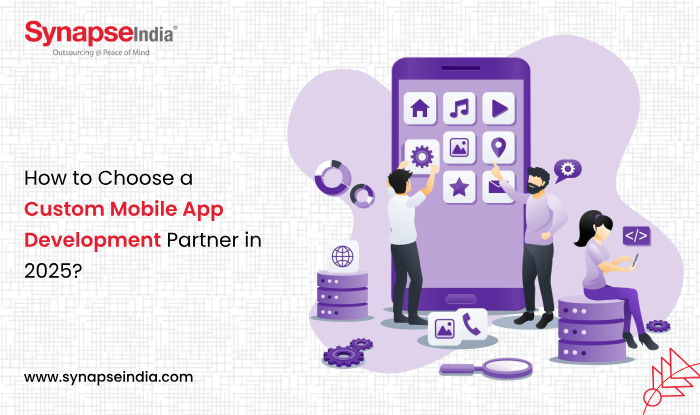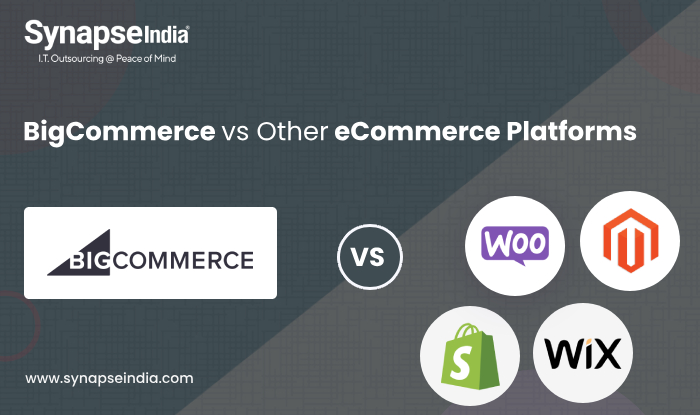 28 Apr 2025
28 Apr 2025“Choosing the right custom mobile app development partner in 2025 is essential for building successful applications. With AI, 5G, and cybersecurity trends, a strong partner ensures scalability and user focus.”

Did you know that by 2025, the global mobile application market is projected to reach $330 billion? With over 75% of mobile interactions expected to be AI-powered, mobile apps are becoming smarter and more integral to business strategies (Precedence Research, Gartner). In this dynamic environment, choosing the right custom mobile app development partner is critical for businesses aiming to stay competitive and meet evolving customer needs.
Selecting a custom mobile app development company that aligns with your vision is directly proportional to your app’s success. Trends like AI integration, cross-platform development, and enhanced cybersecurity are shaping app development in 2025. Partnering with a team that understands these trends and has the expertise to implement them is essential.
At SynapseIndia, we specialize in providing custom mobile app development services tailored to your unique needs, ensuring your app is functional and future-proof. This blog will walk you through the key steps to choose the perfect partner in 2025.

Custom mobile app development is the process of creating mobile applications from the ground up to meet an organization’s unique needs and objectives. Unlike off‑the‑shelf software, these apps are built to align with specific workflows, branding, and feature requirements.
The process typically involves ideation, planning, design, development, testing, and deployment steps that ensure each element supports your business strategy. Custom apps can run on iOS, Android, or both, and may leverage native or cross‑platform frameworks depending on performance and budget considerations.
The development partner acts as an extension of your team, guiding you through each phase of the project. They begin by gathering requirements and assessing business goals to propose the right technology stack and feature set. Next, they craft user interfaces and experiences tailored to your audience, often using wireframes and prototypes to refine design choices.
In the development phase, they write, integrate, and test code for front‑end and back‑end components to ensure the app works smoothly across devices. After launch, they provide ongoing support, fixing bugs, releasing updates, and scaling the app as needs evolve. A strong partner also advises on security best practices, performance optimization, and app store submission, making sure your app stays competitive and compliant.
Before you search for a custom mobile app development partner in 2025, get clear on how technology trends affect your app’s needs. 5G will let your app run faster and more dependably. Internet‑connected devices mean users can control home gadgets from the app. AI can tap into real‑time data to adapt experiences, such as workout apps that change plans based on sleep quality.
Matching these trends is just part of the picture. If your partner falls behind, you could see delays that cost you market share-on‑demand apps may reach $335 billion by 2025. With more than 83 percent of phishing attacks aimed at mobile devices, you need a partner who treats security seriously. Picking a team that stays updated and puts safety first helps you launch a strong, user‑friendly app.
To ensure you choose the right partner, consider the following factors, each supported by trends and statistics for 2025. These are presented in a structured format to enhance readability and provide actionable insights.
Before searching for a custom mobile app development company, clarify your app’s purpose, target audience, and technical requirements. This foundation ensures you communicate your vision effectively and select a partner capable of delivering it.
Start by defining what problem your app solves. Is it an e-commerce platform, a productivity tool, or a social networking app? Identify your target audience—age, location, and preferences—to tailor the app’s features and design. For example, a fitness app for young adults might prioritize gamification, while a healthcare app for seniors needs simplicity and accessibility.
Decide whether your app will run on iOS, Android, or both. In 2025, Android holds approximately 72% of the global mobile operating system market share, while iOS has 28% (Statista). Android dominates in Asia and Africa, while iOS is stronger in North America and Europe. Cross-platform frameworks like Flutter or React Native can reduce costs by using a single codebase for both platforms, but native development (Swift for iOS, Kotlin for Android) may be better for performance-critical apps.
List the must-have features, such as payment gateways, push notifications, or AI-driven recommendations. Define user experience (UX) goals—should the app feel intuitive, fast, or visually engaging? In 2025, users expect personalized experiences, with 80% abandoning apps after three uses if expectations aren’t met (TechCrunch).
Consider scalability—can the app handle increased users or data over time? Starting with a Minimum Viable Product (MVP) allows you to test core features, gather feedback, and iterate. A clear product roadmap outlines future enhancements, ensuring alignment with your partner.
A partner’s technical expertise determines their ability to deliver a high-quality app. Look for a custom mobile app development company with a proven track record and familiarity with modern technologies.
Choose a partner with experience in your industry or similar app types. For example, a healthcare app requires knowledge of HIPAA compliance, while a gaming app needs expertise in AR/VR. Review case studies and client testimonials to assess their success in delivering comparable projects
In 2025, popular tech stacks include Flutter and React Native for cross-platform apps, Swift for iOS, and Kotlin for Android (Technostacks). If your app leverages AI, ensure proficiency in frameworks like TensorFlow or Core ML. For IoT integration, check experience with protocols like MQTT. Ask for examples of apps built with these technologies.
Examine the partner’s portfolio for apps with strong functionality and positive user feedback. Request metrics like download numbers or user retention rates. A reputable custom mobile app development company will share detailed case studies highlighting challenges and solutions.
User-centered design is paramount in 2025, as 88% of users avoid apps after a poor experience (Spdload). A partner’s design capabilities directly impact user engagement and retention.
Look for a partner with a dedicated UX/UI team that conducts user research and follows design thinking principles. They should create wireframes and prototypes to test and refine the user journey. In 2025, trends like minimalist design, AI-driven personalization, and voice interfaces dominate (Mockplus).
Review their UI/UX portfolio for visually appealing and intuitive apps. Check if they use iterative prototyping to incorporate user feedback early. Tools like Figma or Adobe XD are standard for collaborative design processes.
Ensure the partner integrates accessibility best practices, such as WCAG guidelines, to make the app usable for people with disabilities. Features like screen reader support and high-contrast modes are essential for inclusivity.
Agile methodologies are preferred in 2025 for their flexibility and iterative approach, allowing quick adaptation to changing requirements.
A custom mobile app development partner should use agile or hybrid methods, breaking development into sprints for regular feedback and adjustments. This ensures alignment with your vision and market needs. Ask about their sprint duration (typically 2-4 weeks) and review processes.
Expect regular communication through stand-ups, sprint reviews, and progress reports. Tools like Jira, Trello, Slack, and GitHub facilitate project management and version control (SaM Solutions). In 2025, remote collaboration is common, so proficiency in these tools is a must.
With cyberattacks increasing by 47% in 2025, security is a top priority (Wattlecorp). A partner must implement robust security measures and ensure compliance with data privacy laws.
For apps handling sensitive data, compliance with regulations like GDPR, HIPAA, or CCPA is non-negotiable. Ask how the partner ensures compliance, including data protection policies and audit processes.
Key security practices include data encryption, secure APIs, and multi-factor authentication. In 2025, trends like AI-powered threat detection and zero trust architecture are critical for countering sophisticated threats (Analytics Insight). Request details on their security testing and monitoring strategies.
An app’s success depends on continuous support post-launch, especially in 2025’s fast-evolving tech environment.
Choose a partner offering bug fixes, updates for new OS versions, and performance optimizations. With 299 billion app downloads projected in 2025, staying current is essential (LambdaTest).
The partner should integrate analytics tools (e.g., Firebase, Mixpanel) to monitor user behavior and app performance. Ongoing optimization improves user retention and engagement.
Ensure the partner provides clear SLAs, specifying response times for issues and update schedules. This guarantees reliable support and minimizes downtime.
Effective communication and cultural alignment foster a smooth partnership, especially with remote teams in 2025.
Select a partner fluent in your language and responsive to inquiries. Time zone compatibility or overlapping work hours ensures timely communication. Tools like Slack or Microsoft Teams enhance collaboration.
Shared values and work ethics strengthen the partnership. Discuss their approach to problem-solving and client relationships to ensure compatibility.
Beware of vague responses, inconsistent availability, or overpromising. A trustworthy custom mobile app development company sets realistic expectations and maintains transparency.
While cost is a factor, prioritize value over the lowest price to avoid compromising quality.
Understand the partner’s pricing models:
Review contracts for hidden fees, intellectual property (IP) rights, and milestone-based payment plans. Clear terms protect both parties and ensure fair collaboration.
A partner offering robust security, modern tech stacks, and post-launch support may justify a higher cost. In 2025, investing in quality reduces long-term maintenance expenses.
Before you start, SynapseIndia helps you define your app’s goal, audience, and must-have features. Our team learns what problem you’re solving, whether it’s e‑commerce, productivity, or a unique niche, and who will use it, down to age and preferences. With that in hand, we recommend the right tech stack and design a simple, user‑friendly interface.
During development, we keep you in the loop with frequent updates and feedback sessions. We handle frontend and backend work, integrate APIs, and run thorough tests to catch issues early. Security and performance are built in from day one.
Once your app goes live, we don’t just walk away. SynapseIndia offers ongoing support for bug fixes, updates, and scaling as your user base grows. Our clear communication and structured process mean you get an app that fits your vision, meets user needs, and stays reliable over time, all without the headaches of managing every technical detail yourself.

Choosing a custom mobile app development partner in 2025 requires careful consideration of technical expertise, design capabilities, security practices, and support services. By defining your requirements, evaluating potential partners against these criteria, and prioritizing value, you can ensure your app thrives in a competitive market.
Ready to bring your app idea to life?
Contact SynapseIndia for expert custom mobile app development services that will help your business succeed in 2025 and beyond.


 29 Jan 2024
29 Jan 2024
 01 Jun 2024
01 Jun 2024.jpg)
 31 Jan 2025
31 Jan 2025
